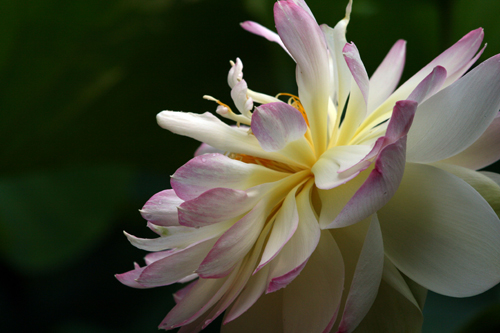 Sacred Lotus
Sacred Lotus
The sacred lotus, Nelumbo nucifera, is a rhizomatous aquatic perennial native to the rivers and ponds of Asia and northern Australia.
The plant’s life cycle is steeped in symbolism, as stalks and leaves ascend from muddy soil and still waters to form a large, beautiful—albeit brief—blossom that opens as wide as 12 inches across.
The Garden’s collection of Nelumbo nucifera includes 'Empress,' 'Alba Plena,' and 'Improved Egyptian Pink' in the Japanese Garden. The plants are planted in a large enclosed bed along the banks in the southeast corner of the lake.
Their growth spans the seasons, as winter’s withered brown leaves make way for spring’s quick growth, and then summer’s short-lived flowers, followed by their signature seed pods. Individual flowers remain effective for about a week.
All buds don’t open simultaneously, so the overall peak season of bloom of the collection lasts for about two weeks.
Look for the lotuses expansive canopy of blue-green leaves, up to two to three feet in diameter, that may lie flat upon the water, or rise on stalks more than five feet above the water line. Their leaves are coated with a waxy substance that causes water droplets to bead up on the surface.
Home Gardening / Water Gardens
Home gardeners short on space can enjoy dwarf cultivars such as Nelumbo ‘Momo Botan’ which can be grown in barrels and in ponds deep enough to prevent the freezing of the plant’s roots. Garden visitors can view Nelumbo ‘Momo Botan’ in the Chinese Garden and the English Woodland Garden. Learn more about water gardening
Water lily? Not really! Don’t confuse the Garden’s impressive collection of (Victoria amazonica) in the Central Axis with the equally unique lotus bed in the Japanese Garden. One of the most easily observed differentiations between the plants is the large central seed head of the lotus. Nucifera means “nut-bearing,” and the absence of this feature in water lilies is one of several differences between these two summertime stunners at the Garden. Look for water lilies to be at their peak in late August to early September.